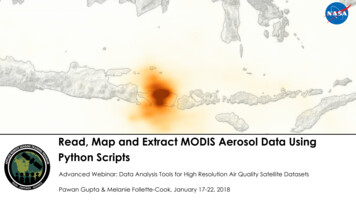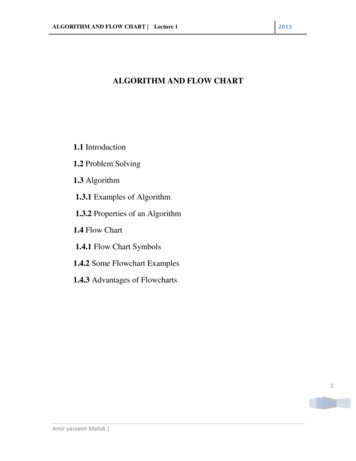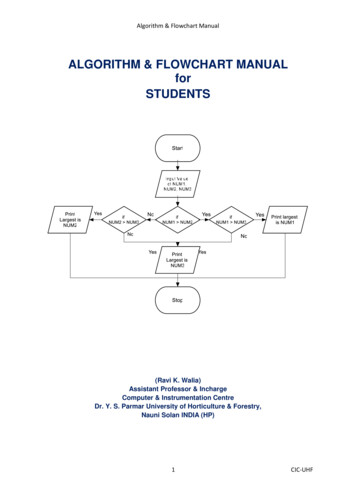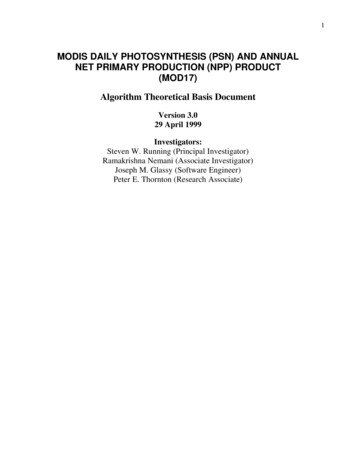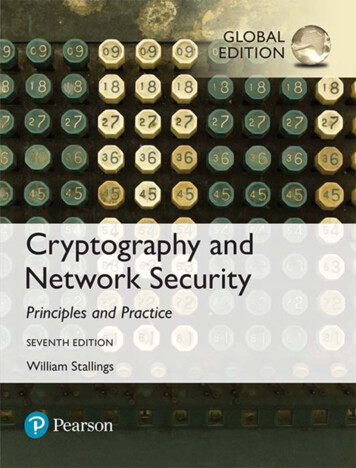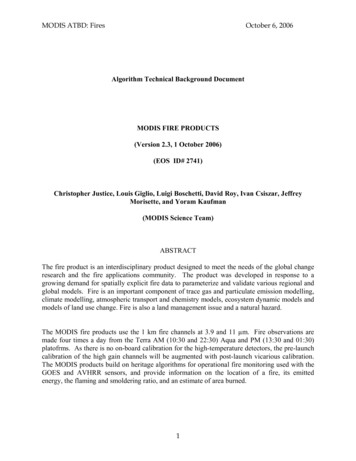
Transcription
MODIS ATBD: FiresOctober 6, 2006Algorithm Technical Background DocumentMODIS FIRE PRODUCTS(Version 2.3, 1 October 2006)(EOS ID# 2741)Christopher Justice, Louis Giglio, Luigi Boschetti, David Roy, Ivan Csiszar, JeffreyMorisette, and Yoram Kaufman(MODIS Science Team)ABSTRACTThe fire product is an interdisciplinary product designed to meet the needs of the global changeresearch and the fire applications community. The product was developed in response to agrowing demand for spatially explicit fire data to parameterize and validate various regional andglobal models. Fire is an important component of trace gas and particulate emission modelling,climate modelling, atmospheric transport and chemistry models, ecosystem dynamic models andmodels of land use change. Fire is also a land management issue and a natural hazard.The MODIS fire products use the 1 km fire channels at 3.9 and 11 µm. Fire observations aremade four times a day from the Terra AM (10:30 and 22:30) Aqua and PM (13:30 and 01:30)platofrms. As there is no on-board calibration for the high-temperature detectors, the pre-launchcalibration of the high gain channels will be augmented with post-launch vicarious calibration.The MODIS products build on heritage algorithms for operational fire monitoring used with theGOES and AVHRR sensors, and provide information on the location of a fire, its emittedenergy, the flaming and smoldering ratio, and an estimate of area burned.1
MODIS ATBD: FiresOctober 6, 2006In MemoriamIn the early years of MODIS, the approach to the active fire algorithm wasdeveloped in close cooperation with Dr. Yoram Kaufman and his team at NASAGSFC. We had many useful discussions on the physics of fire and the designand utility of the product, which shaped much of what has been done. Yoramwas instrumental in the early development of the MODIS fire product and firecharacterization and its application to aerosol studies.His continuingcontribution to the evolution of the product is sorely missed.2
MODIS ATBD: FiresOctober 6, 2006Table of Contents1. Introduction2. Overview and Technical Background2.1 Science Rationale3. MODIS Active-Fire Algorithm and Products3.1 Theoretical description3.1.1 Physics of the Problem3.1.2 Fire Detection3.1.3 Fire Characterization3.2 The MODIS Active Fire Products3.2.1 Level 2 Fire Products3.2.2 Level 2G Daytime and Nighttime Fire Products3.2.3 Level 3 8-Day Daily Composite Fire Products3.2.4 Level 3 8-Day Summary Fire Products3.2.5 Climate Modeling Grid Fire Products3.3 Validation of the MODIS Active Fire Products3.3.1 ASTER Fire Detection3.3.2 Validation Results Using ASTER Imagery4. Burned Area Product Theoretical Description4.1 The MCD45 Product4.2 Inputs4.3 MODIS Burned Area Discrimination Issues4.3.1 Wavelength Selection4.3.2 Surface Bi-Directional Reflectance Effects4.4 The Global MODIS Algorithm for Burned Area Mapping4.4.1 The Bi-Directional Reflectance Model-Based Expectation Approach4.4.2 Temporal Implementation4.4.3 Iterative Procedure for Identification of Burned Candidates4.5 Data FormatAcknowledgmentsReferences3
MODIS ATBD: FiresOctober 6, 20061. INTRODUCTIONThe MODIS fire products build and improve on the experience of fire assessmentprimarily using the NOAA-AVHRR and GOES systems. Currently no other system provides theinstrument characteristics needed for an effective global fire monitoring program. The MODISsensor was designed to include characteristics specifically for fire detection and provides aunique capability over existing sensors in terms of fire monitoring. The fire products include anidentification of the occurrence of thermal anomalies, an estimate the total emitted power fromthe fire and burned area.Many users are ultimately interested in the area of land that is burned. This can beobtained through detection of burn scars. MODIS offers unique spatial and radiometriccapabilities for burn scar detection. An automatic procedure for burn scar detection has beendeveloped has now been implemented in the MODIS production stream. The products areavailable at full resolution and as spatial summaries and temporal composites.The products are in differing stages of maturity and each product has an explicitvalidation program.2. OVERVIEW AND TECHNICAL BACKGROUND2.1 SCIENCE RATIONALEThe MODIS fire products provide an important input to research programs in several indifferent scientific disciplines. Fire is an important process within a most terrestrial biomes, andthe release of gases and particulate matter during biomass burning is an important contributor tothe chemical reactions and physical processes taking place in the atmosphere. Fire is asignificant and continuous factor in the ecology of savannas, boreal forests and tundra, and playsa central role in deforestation in tropical and sub-tropical regions. In addition, on a periodicbasis, extensive fire occurs in many temperate biomes such as forests, grasslands, and chaparral.Monitoring the location and areal extent of biomass burning and its associated effects areimportant in the context of the goals and objectives of the US Global Change Research Program: Fire changes the physical state of the vegetation, releasing a variety of greenhouse gasesinto the atmosphere. There is presently great uncertainty as to the magnitude of thesources and sinks of these greenhouse gases. For example, the net annual release ofcarbon into the atmosphere due to the clearing and conversion of tropical forests foragricultural purposes (where biomass burning is a key tool used in the conversionprocess) is thought to contribute approximately 30% to the net annual increase in theconcentration of atmospheric CO2. In addition, there is an interest in changes in regionalfire regimes under different climate change scenarios. For example, arguments havebeen made that an increase in average air temperature in northern latitudes will lead to adecrease in the natural fire return interval and an increase in fire severity in boreal forestand tundra ecosystems. This in turn, could lead to a significant reduction of the carbonstored in these ecosystems, with a comparable increase in atmospheric carbon. The release of chemically-reactive gases during biomass burning strongly influenceschemical processes within the troposphere. In tropical regions, biomass burning has beenshown to strongly influence regional and global distributions of tropospheric ozone and4
MODIS ATBD: FiresOctober 6, 2006has been related to acid deposition. Studies have shown that intensive biomass burningassociated with naturally occurring forest fires, deforestation practices and savannamanagement is a major source of trace gases such as NO, CO2, CO, O3, NOx, N2O,NH3, SOx, CH4, other non-methane hydrocarbons, as well as an abundant source ofaerosols (Stith et al., 1981; Crutzen et al., 1985; Fishman et al., 1986; Andreae et al.,1988; Browell et al., 1988; Kaufman et al., 1992). Preliminary global estimates indicatethat annual biomass burning may be associated with 38% of the ozone in the troposphere;32% of global carbon monoxide; more than 20% of the world's hydrogen, nonmethanehydrocarbons, methyl chloride and oxides of nitrogen; and approximately 39% of theparticulate organic carbon (Levine, 1991; Andreae, 1991). Although these estimatesinclude a wide range of uncertainty, it is becoming evident that these emissions may beas important to global atmospheric chemistry as industrial activities in the developedworld (Crutzen et al., 1985; Crutzen and Andreae, 1990). It is estimated that as much as70 to 80% of the total biomass burned globally each year is burned in the equatorial andsubtropical regions (Greenburg et al., 1984; Andreae, 1991). Some of the most intensivebiomass burning activities are associated with deforestation and grassland management inSouth America, South East Asia and sub-Saharan Africa (Malingreau, 1990). Thetropics receive the maximum amount of visible and ultra-violet radiation, thus acting as aprimary driving force for atmospheric circulation. Since most biomass burning in thetropics is limited to a burning season, the temporal and spatial concentration of emissionsare expected to have a noticeable impact on atmospheric chemistry and climate in thetropics and globally as a result of increased trace gas emissions and the direct andindirect radiative effects of smoke aerosols. The release of soot and other particulate matter during fires leads to significant physicalchanges within the troposphere in the region down-wind from the fire effecting airquality. First, depending on the single scattering albedo, particulate matter can result in awarming or cooling of the climate. Second, particles emitted from fires can effect cloudmicrophysics and radiative properties. The particles serve as cloud condensation nucleiand result in an increase in cloud cover and more reflective clouds. This increase incloud cover increases the albedo of the atmosphere and reduces the average airtemperature. In addition, these clouds also affect precipitation patterns. Recent analyseshave indicated that the direct and indirect radiative effects of aerosols from biomassburning may be significant to the radiative balance of the earth and may be a major factorin climate change (Coakley et al., 1983; Twomey et al., 1984; Charlson et al., 1991;Kaufman et al., 1991; Twomey, 1991; Penner et al., 1992). Although the overall effectsof aerosol loading from biomass burning are not very well understood. The two primaryradiatively active components of aerosol emissions from biomass burning are particulateorganic and graphitic carbon. Particulate organic carbon is the largest constituent andgenerally serves to scatter incoming solar radiation, while graphitic carbon particles canincrease the solar radiation absorption in the atmosphere and clouds. The primary directeffect of particulate organic carbon aerosols is that they reflect incoming solar radiationback to space and act to cool the surface. The indirect effects of particulate organiccarbon are associated with the ability for these aerosols to act as cloud condensationnuclei (CCN). Clouds are one of the most important controls on the heat balance of theearth.5
MODIS ATBD: FiresOctober 6, 2006A number of studies have been done to characterize the effects of aerosols due toanthropogenic pollution and biomass burning on clouds and climate (Stith et al., 1981;Twomey et al., 1984; Coakley et al., 1987; Hallett et al, 1989; Hudson, 1991; Rogers etal., 1991; Leaitch, et al., 1992). For thin to moderate clouds, increased CCN loading isthought to result in an increase in reflectivity and cloud albedo. Increased CCN loadinggenerally results in increased droplet formation of a smaller size given a constant amountof available water. Clouds which are made of smaller droplets are usually assumed to bewhiter, reflect more solar radiation and may be less likely to produce rain (Radke et al.,1990; Andreae, 1991). Previous results obtained by Kaufman and Nakajima (1993),which focused mainly on low level cumulus and stratocumulus clouds, indicated that inthe Amazon high concentrations of smoke aerosols lead to a decrease in the cloud dropsize but actually reduced the reflectivity of related clouds as a result of absorption bygraphitic carbon. These results are consistent with those presented by Twomey (1977),which suggested that for optically thin clouds an increase in cloud drop concentrationwould result in a greater reflectivity, while for clouds which are optically thick and verybright to begin with, the effect of increased cloud drops would be dominated byabsorption and reduction of cloud brightness. The results of natural fire or processes associated with fire affect the exchange of energyand water between land surfaces and the atmosphere. Fires can result in a decrease in thesurface albedo and increase in the amount of solar radiation reaching the soil layer atlocal and regional scales. These, in turn, increase the amount of absorbed energy fromincoming solar radiation, and generally increase the ground temperature. The changes inground temperature affect a wide range of processes, including nutrient and wateravailability and microbial respiration. Removal of the plant canopy during fire reducesthe amount of evapotranspiration and typically results in more water runoff. In tropicalforests, the land clearing associated with biomass burning has resulted in a significantreduction of total precipitation in the region, and increase the surface runoff, soil erosionand river sedimentation. In tropical forests, activities associated with biomass burningand land clearing lead to an overall reduction in the amounts of precipitation in regionsdown-wind from the affected areas. First, the smoke from fires act as cloud condensationnuclei, and form additional water droplets in clouds; however, these droplets are typicallysmaller than those found in clouds found over tropical regions, and result in lower levelsof precipitation. Second, land clearing and continuous burning leads to the conversion offorest to savanna. The grasses dominating the savannas have a much lower rate ofevapotranspiration than trees, resulting in less water being returned to the atmosphere.Finally, savannas are much more susceptible to surface runoff, resulting in moreprecipitation flowing into streams and rivers. In addition, once the overlying vegetationof a tropical forest has been removed the exposed soil surface then becomes susceptibleto erosion and the wetland and river systems are subject to sedimentation.In boreal forests, there is a dependence on the melting and formation ofpermafrost and the occurrence of fire, which in turn has a strong influence on thehydrology of these sites. In boreal forests, fire effects the flow of energy between theatmosphere and ground layer dramatically. First, fire removes a large portion of thevegetation layer which shades the ground, thus increasing the solar energy reaching theground. Second, it decreases the albedo of the ground layer, increasing the amount of6
MODIS ATBD: FiresOctober 6, 2006energy absorbed by the ground layer. And third, fire removes much of the dead organicmatter layer which insulates the ground. It has been shown that during the first year aftera fire in a black spruce forest underlain by permafrost, there is a 5K to 7K increase in thetemperature of the ground layer, which in turn causes a melting of the permafrost layerand an increase in the soil moisture in the active layer. The ground layer of these fireaffected areas remains affected for at least 15 to 25 years, with the depth of thaw of theactive layer increasing also. Because of the melting permafrost and lack of a transpiringvegetation layer, during the initial years after a fire there is an increase in the moisture ofthe ground layer; however, after a few years, when the active layer becomes deeper, thereis better drainage for the surface moisture, which then decreases. Finally, after about 20to 25 years, the ground layer becomes cooler (as the vegetation layer becomes reestablished, along with an increase in the depth of the dead organic matter layer), theactive layer becomes shallower, and the ground layer moisture increases because ofpoorer drainage. Fires have several direct and indirect effects on terrestrial ecosystems. First, the patternof fire (which includes its spatial distribution, fire return interval, and severity ofburning) directly controls plant community development within those landscapes wherebiomass burning occurs. Fire favors those plants and tree species which have developedadaptations to fire (e.g., vegetative reproduction and fire-resistant seeds and cones) andeliminates those species which are less resistant to fire. Second, fire indirectly affectsplant community development in a variety of ways, including (a) addition of key plantnutrients through ash fertilization or increased soil decomposition; (b) depletion of keyplant nutrients through surface runoff or increased soil leaching; and (c) altering soiltemperature and moisture. Finally, chemical reactions of the gases released by fire leadsto an increase in atmospheric ozone and the deposition of acidic compounds downwindfrom fires, which in turn can effect the physiology of plants and ecosystems in theseareas.Fire has been identified by the international community as being an important variable for theGlobal Climate Observing System and an essential climate variable for the FraneworkConvention on Climate Change.7
MODIS ATBD: FiresOctober 6, 20063. MODIS ACTIVE-FIRE ALGORITHM DESCRIPTION3.1 THEORETICAL DESCRIPTIONThe MODIS fire detection and characterisation techniques are fully automated for theproduction of daily, global fire information. In order to detect the presence of fire in a noninteractive fashion, a set of detection criteria different for the day and night fire observations areprescribed. These multipsectral criteria are based on the apparent temperature of the fire pixeland the difference between the fire pixel and its background temperature.3.1.1 PHYSICS OF THE PROBLEMThe distinct flaming and smoldering fire stages are characterized by different fireintensity, temperature, and emission ratios. In several field experiments in Brazil Ward et al.,measured 2-3 times as much emission of aerosol particles, CH4 and NMHC in the smolderingphase as in the flaming phase (Ward et al., 1992; Kaufman et al., 1992). Therefore it is importantto be able to distinguish between these two phases. The availability of oxygen to the fire, is afunction of the fire intensity and structure. It determines the fraction of burned carbon released asCO and the fraction of black carbon in the aerosol particles (Crutzen and Andreae, 1990). Thefire intensity and structure affect the fire temperature and the spatial extent of the hot zone.Smoldering and flaming can be distinguished using infrared remotely-sensedmeasurements only if the fire temperatures vary significantly between these two stages. Basedon a review of fire properties by Lobrt and Warnatz (1993) flaming temperature can be anywherebetween 800 K and 1200 K, and as hot as 1800 K. Smoldering should be under 850 K and above450 K. The actual range is probably smaller. The algorithm and sensitivity studies were based,therefore, on the assumption that the flaming temperature is 1000 K 200 K and the smolderingtemperature is 600 K 100 K.In a given fire pixel we may have areas that are not burned, areas that are smoldering andareas that are in flames. Figure 1 demonstrates the sensitivity of various MODIS channels to thefraction of the pixel covered by flames of 1000K (fflame), and fraction of the pixel covered bysmoldering of 600K (fsmold). The rest of the pixel is in temperature of 300K. The shorter thewavelength, the stronger the sensitivity to the higher temperature region. The main results aresummarized in Table 1.The 1.65 µm channel is very sensitive to fflame and the flaming energy and not verysensitive to fsmold and its energy. The 2.13 µm channel is very sensitive to fflame and somewhatsensitive to fsmold. Since the thermal energy is more concentrated in the flaming fire, thesensitivity to thermal energy is independent of smoldering or flaming. Unfortunately theMODIS 2.13 µm channel saturates at a reflectance of 0.8, which for the low solar brightnesscorresponds to less than 1% of the 500 m pixel being in flames. The importance of this channelis therefore limited. The 4 µm channel is sensitive to both fflame and fsmold, and is five timesmore sensitive to the thermal energy emitted from flaming than from smoldering. Fig. 2 showsthe effect of fire size and temperature on the apparent temperature of the pixel at 4 µm. Thischannel is sensitive to fires as small as 10-4 of the fire pixel.8
MODIS ATBD: FiresOctober 6, 2006The 4 µm channel response in daytime may be strongly enhanced by surface reflectionwhere the satellite-surface-solar geometry results in sunglint. This effect has been documentedover oceans (Nath et al., 1993; Cracknell, 1993) and can lead to false fire detections over land(Alberto Setzer, pers. comm.). Therefore the MODIS fire algorithm tests for sun glint andexcludes those pixels from the fire products.Fig. 1: The sensitivity of the MODIS channels to the fraction of the pixel covered by flames of1000K (fflame), and fraction of the pixel covered by smoldering of 600 K. The rest of the pixel isassumed to have a temperature of 300 K.9
MODIS ATBD: FiresOctober 6, 2006Table 1: Information on the MODIS bands that can be used for fire detection. Thesaturation is given in reflectance units for the solar bands (ρ) or in temperature units (T) for thethermal bands. The sensitivity is given in kelvins change ( T) per change in the area covered byfire (f) or in change in the apparent surface reflectance ( ρ).channelspatialsaturationresolution1.65 µm500 m2.13 µm500 m3.96 µm1000 m11 µm1000 mρ 1(740 K)ρ 0.8(570 K)500 K400 Kfraction of pixel thatsaturates the channelat 1000K at 600K0.05nosaturation0.0070.65sensitivity ( ρ/ f)and ( T/ f)at 600 K ρ/ f 0.064sensitivity ( ρ/ f)and ( T/ f)at 1000 K ρ/ f 220 ρ/ f 1.2 ρ/ f 1100.0250.30 T/ f 800 T/ f 83000.25at f 0.05 T/ f 485at f 0.05at f 0.005 T/ f 1700at f 0.0050.07APPARENT FIRE TEMPERATUREFOR THE 3.96 µm channelfiretemperature( K)TEMPERATURE OF THE PIXEL ( K)8001000800900700700600600MODIS saturation50050040030040000.010.11FRACTION OF THE PIXEL COVERED BY THE FIREFig. 2: The apparent temperature of the pixel at 3.96 µm, as observed by MODIS, for a singlefire as a function of the fraction of the pixel covered by the fire and its temperature.10
MODIS ATBD: FiresOctober 6, 20063.1.2 FIRE DETECTIONFire detection is performed using a contextual algorithm (Giglio et al., 2003) that exploitsthe strong emission of mid-infrared radiation from fires (Dozier, 1981; Matson and Dozier,1981). The algorithm examines each pixel of the MODIS swath, and ultimately assigns to eachone of the following classes: missing data, cloud, water, non-fire, fire, or unknown.The algorithm uses brightness temperatures derived from the MODIS 4 µm and 11 µmchannels, denoted by T4 and T11, respectively. The MODIS instrument has two 4 µm channels,numbered 21 and 22, both of which are used by the detection algorithm. Channel 21 saturates atnearly 500 K; channel 22 saturates at 331 K. Since the low-saturation channel (22) is less noisyand has a smaller quantization error, T4 is derived from this channel whenever possible.However, when channel 22 saturates or has missing data, it is replaced with the high saturationchannel to derive T4. T11 is computed from the 11 µm channel (channel 31), which saturates atapproximately 400 K. The 12 µm channel (channel 32) is used for cloud masking; brightnesstemperatures for this channel are denoted by T12.The 250 m resolution red and near-infrared channels, aggregated to 1 km, are used toreject false alarms and mask clouds. The 500-m 2.1 µm band, also aggregated to 1 km, is used toreject water-induced false alarms. A summary of all MODIS bands used in the algorithm isshown in Table 2.Pixels lacking valid data are immediately classified as missing data and excluded fromfurther consideration. Cloud and water pixels are identified using an internal cloud mask and thewater mask a within the MODIS Level 1A geolocation products (MOD13 and MYD03), and arerespectively assigned the classes cloud and water. Processing continues on the remaining clearland pixels.A preliminary classification is used to eliminate obvious non-fire pixels. For thosepotential fire pixels that remain, an attempt is made to use the neighboring pixels to estimate theradiometric signal of the potential fire pixel in the absence of fire. Valid neighboring pixels in awindow centered on the potential fire pixel are identified and are used to estimate a backgroundvalue. The window starts as a 3 3 pixel square ring around the potential fire pixel. Due to thetriangular along-scan response of the MODIS instrument (Kaufman et al., 1998b), the two alongscan pixels adjacent to the potential fire pixel are deemed unreliable and excluded from thebackground characterization. The ring is increased to a maximum of 21 21 pixels, asnecessary, until at least 25% of the pixels within the window have been deemed valid, and thenumber of valid pixels is at least eight. During this step, an optimized nearest-neighbor search isused to correct for the bowtie'' effect, or overlap between MODIS scans (Nishihama et al.,1997).If the background characterization was successful, a series of contextual threshold testsare used to perform a relative fire detection. These look for the characteristic signature of anactive fire in which both 4 µm brightness temperature and the 4 and 11 µm brightnesstemperature difference depart substantially from that of the non-fire background. Relativethresholds are adjusted based on the natural variability of the background. Additionalspecialized tests are used to eliminate false detections caused by sun glint, desert boundaries, anderrors in the water mask. Candidate fire pixels that are not rejected in the course of applyingthese tests are assigned a class of fire. Pixels for which the background characterization couldnot be performed, i.e. those having an insufficient number of valid pixels, are assigned a class ofunknown.11
MODIS ATBD: FiresOctober 6, 2006See Giglio et al. (2003) for a detailed description of the detection algorithm.Table 2: MODIS channels used for active-fire detection and characterization.CentralChannel wavelength (µm) Purpose10.65Sun glint and coastal false alarm rejection; cloud masking.20.86Bright surface, sun glint, and coastal false alarm rejection;cloud masking.72.1Sun glint and coastal false alarm rejection.213.96High-range channel for fire detection and characterization.223.96Low-range channel for fire detection and characterization.3111.0Fire detection, cloud masking.3212.0Cloud masking.3.1.3 FIRE CHARACTERIZATIONFor each fire pixel detected, the fire radiative power (FRP) within the pixel is estimatedusing the empirical relationship of Kaufman et al. (1998):FRP (4.34 10 19 MW K 8 km 2 )(T48 T4 )Apix ,where T4 is the 4-µm brightness temperature of the fire pixel, T4 is the mean 4-µm brightnesstemperature of the non-fire background, and Apix is the total area (in km2) of the pixel in whichthe fire was detected. The resulting value of the FRP is expressed in MW.3.2 THE MODIS ACTIVE FIRE PRODUCTSDescriptions of the current standard MODIS fire products are provided in the followingfive sections. More detailed descriptions can be found in the MODIS Active-Fire Product User’sGuide1.3.2.1 LEVEL 2 FIRE PRODUCTS: MOD14 (TERRA) AND MYD14 (AQUA)This is the most basic fire product in which active fires and other thermal anomalies, suchas volcanoes, are identified. The Level 2 product is defined in the MODIS orbit geometrycovering an area of approximately 2340 by 2030 km in the across- and along-track directions,respectively. It is used to generate all of the higher-level fire products, and contains thefollowing components: 1An active fire mask that flags fires and other relevant pixels (e.g. cloud);a pixel-level quality assurance (QA) image that includes 19 bits of QA information abouteach pixel;a fire pixel table which provides 19 separate pieces of radiometric and internal-algorithminformation about each fire pixel detected within a granule;extensive mandatory and product-specific metadata;http://modis-fire.umd.edu/products.asp12
MODIS ATBD: Fires October 6, 2006a grid-related data layer to simplify production of the Climate Modeling Grid (CMG) fireproduct (see Section 3.2.5).Product specific metadata within the Level 2 fire product includes the number of cloud,water, non-fire, fire, unknown, and other pixels occurring within a granule to simplifyidentification of granules containing fire activity.3.2.2 LEVEL 2G DAYTIME AND NIGHTTIME FIRE PRODUCTS: MOD14GD/MOD14GN(TERRA) AND MYD14GD/MYD14GN (AQUA)The Level 2 active fire products sensed over daytime and nighttime periods are binnedwithout resampling into an intermediate data format referred to as Level 2G. The Level 2Gformat provides a convenient geocoded data structure for storing granules and enables theflexibility for subsequent temporal compositing and reprojection. The Level 2G fire products area temporary, intermediate data source used solely for producing the Level 3 fire products and areconsequently not available from the permanent MODIS data archive.3.2.3 LEVEL 3 8-DAY DAILY COMPOSITE FIRE PRODUCTS: MOD14A1 (TERRA) ANDMYD14A1 (AQUA)The MODIS daily Level 3 fire product is tile based, with each product file spanning oneof the 460 MODIS tiles, 326 of which contain land pixels (Figure 3). The product is a 1-kmgridded composite of fire pixels detected in each grid cell over each daily (24-hour) compositingperiod. For convenience, eight days of data are packaged into a single file.3.2.4 LEVEL 3 8-DAY SUMMARY FIRE PRODUCTS: MOD14A2 (TERRA) ANDMYD14A2 (AQUA)The MODIS daily Level 3 8-day summary fire product is tile-based, with each productfile spanning one of the 460 MODIS tiles, of which 326 contain land pixels. The product is a 1km gridded composite of fire pixels detected in each grid cell over each 8-day compositingperiod.3.2.5 CLIMATE MODELING GRID FIRE PRODUCTS (MOD14CMH, MYD4CMH, ETC.)The CMG fire products are gridded statistical summaries of fire pixel informationintended for use in regional and global modeling. The products are currently generated at 0.5spatial resolution for time periods of one calendar month (MOD14CMH/MYD14CMH) andeight days (MOD14C8H/MYD14C8H). Higher resolution 0.25 CMG fire products are plannedfor Collection 5 as well.13
MODIS ATBD: FiresOctober 6, 2006Figure 3: MODIS tiling scheme.3.3 VALIDATION OF THE MODIS ACTIVE FIRE PRODUCTSStage 2 validation of the Terra MODIS fire products is nea
into the atmosphere. There is presently great uncertainty as to the magnitude of the sources and sinks of these greenhouse gases. For example, the net annual release of carbon into the atmosphere due to the clearing and conversion of tropical forests for agricultural purposes (w
